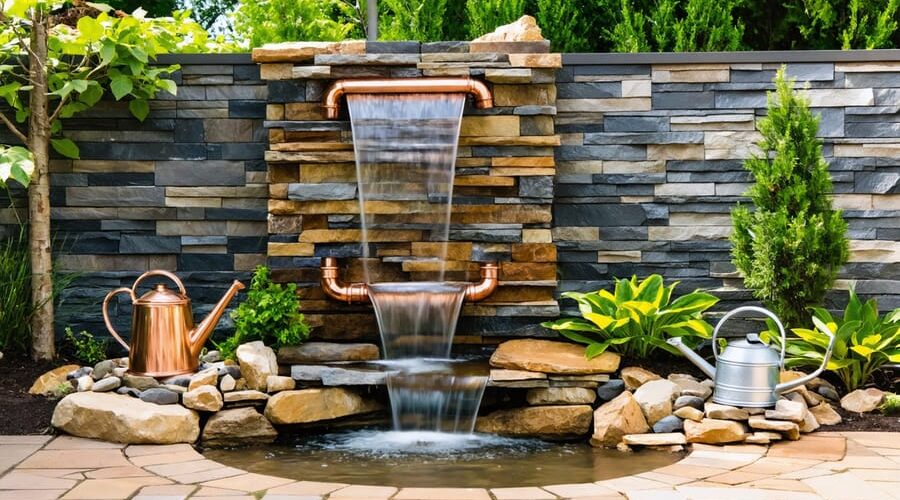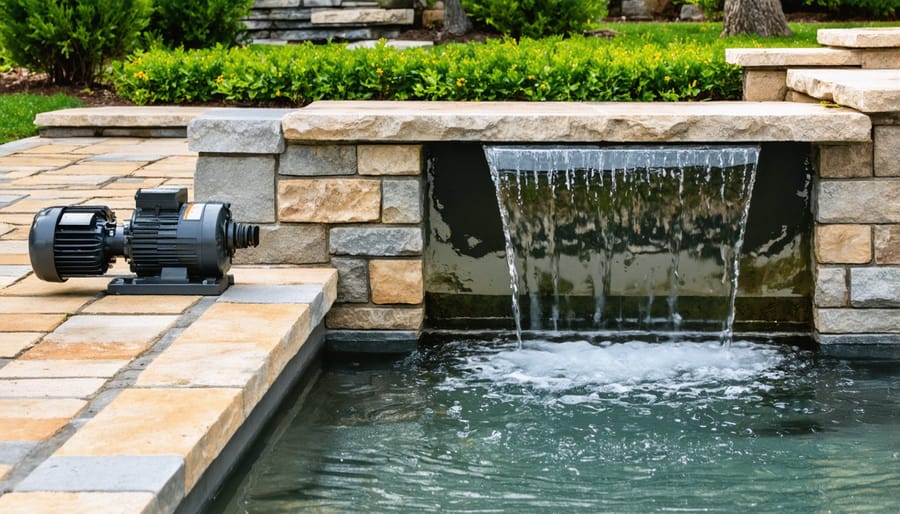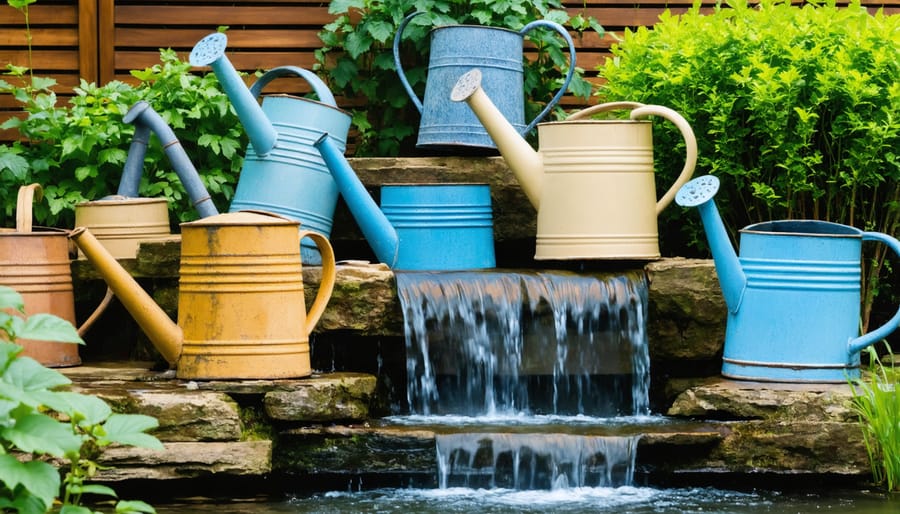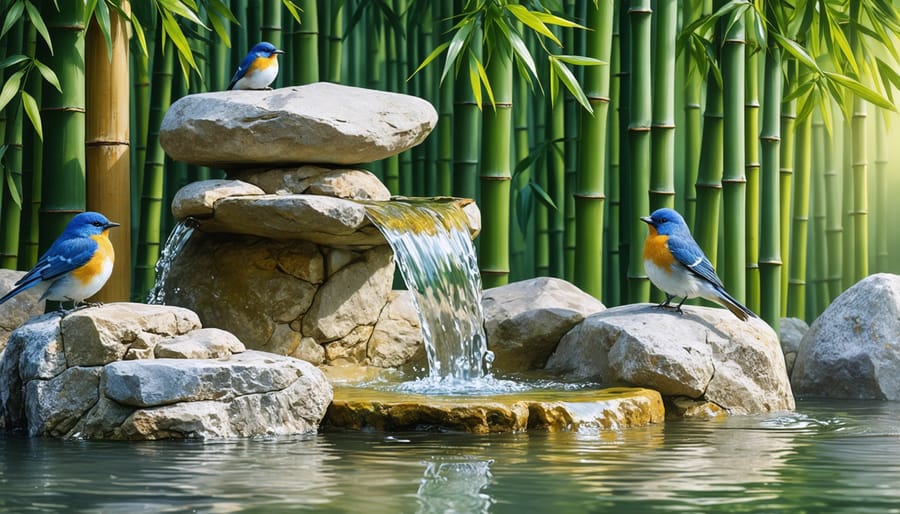
Beautiful DIY Water Features You Can Build This Weekend (Using Easy-to-Find Materials)
Transform your backyard into a tranquil oasis with stunning DIY water features that cost a fraction of professional installations. From simple tabletop fountains to impressive cascading waterfalls, creating your own water feature combines the satisfaction of hands-on crafting with the soothing ambiance of flowing water. Whether you’re working with a modest balcony or a sprawling garden, dozens of customizable options fit every space and skill level.
Start with basic materials like ceramic pots, bamboo spouts, or repurposed items to craft unique fountains that reflect your personal style. Stack natural stones for a rustic waterfall, convert old watering cans into whimsical pour spouts, or design a modern wall fountain using copper pipes and slate tiles. Solar-powered pumps eliminate complex wiring, while submersible LED lights create magical evening displays.
Ready to dive in? This guide explores practical DIY water feature ideas that combine beauty, functionality, and budget-friendly solutions, helping you create your perfect outdoor sanctuary step by step.
Essential Materials for DIY Water Features

Waterproofing and Liner Options
Choosing the right waterproofing solution is crucial for a long-lasting water feature. Pre-formed rigid liners offer a quick solution for small projects, while flexible pond liners give you more creative freedom with shape and size. EPDM rubber liners are highly durable and UV-resistant, making them perfect for larger installations and sunny locations. PVC liners are more budget-friendly but may need replacement sooner.
For container water features, you can use waterproof sealants specifically designed for concrete, metal, or wood. A quality pond liner underlay helps prevent punctures from sharp rocks or roots. When working with natural stone or concrete features, consider using a concrete waterproofer or sealant to prevent water loss through porous surfaces.
Remember to create multiple layers of protection – start with proper ground preparation, add cushioning underlay, install your chosen liner, and seal all joints and connections carefully. For areas where the liner will be visible, consider using decorative stone or plants to conceal it while maintaining its waterproofing integrity. Always check for leaks before adding decorative elements to save time and effort later.
Pump and Plumbing Selection
When it comes to choosing the right water pump and plumbing for your DIY water feature, size matters! For small fountains, a submersible pump rated at 50-100 gallons per hour usually does the trick. Larger features might need pumps with 500+ GPH capacity. Remember to factor in your feature’s height – you’ll need extra power to push water upward.
For plumbing, flexible vinyl tubing is perfect for most DIY projects. It’s affordable, easy to work with, and available at any hardware store. Choose tubing with a diameter matching your pump’s outlet – typically ½ inch or ¾ inch. For a more professional look, consider using rigid PVC pipes, especially for permanent installations.
Don’t forget these essential components: check valves to prevent backflow, ball valves to control water flow, and appropriate connectors for your tubing. A pre-filter for your pump will help prevent clogging and extend its life. Always use waterproof electrical connections and keep your pump accessible for maintenance. A properly sized pump and well-planned plumbing system will ensure your water feature runs smoothly for years to come.
Budget-Friendly Material Options
Repurposed and Upcycled Materials
Creating stunning water features doesn’t mean spending a fortune on new materials. Repurposing garden items and everyday objects can lead to unique, eco-friendly designs that add character to your outdoor space. Old watering cans make charming waterfall features when mounted on a wall or post, while ceramic pots can be transformed into tranquil fountains with minimal effort.
Consider salvaging unused items from your garage or local thrift stores. Vintage bicycle wheels can become mesmerizing spinning water wheels, and old metal wash basins create perfect catch basins for cascading features. Glass bottles, particularly wine bottles, can be arranged to create colorful water walls, while copper pipes can be bent and arranged for artistic water spouts.
Wooden wine barrels, split in half, make excellent pond bases or waterfall features. Old metal washtubs, galvanized buckets, and even kitchen colanders can find new life as water feature components. For a rustic look, repurpose old farm equipment like metal milk cans or water pumps as centerpieces for your water feature.
Remember to thoroughly clean all repurposed items and ensure they’re water-safe before use. Apply appropriate sealants to wooden items, and check metal pieces for rust or sharp edges that could cause safety concerns. With creativity and proper preparation, everyday items can become extraordinary water features that tell a story while soothing your garden space.

Natural Material Alternatives
Natural materials can transform your DIY water feature into a stunning organic masterpiece that blends seamlessly with your landscape. River rocks and smooth pebbles are perfect for creating natural-looking stream beds or pond edges, and they help hide liner edges while providing a peaceful aesthetic. You can collect these from local landscaping suppliers or even from permitted natural areas.
Bamboo is an excellent choice for creating Asian-inspired water features. Use hollow bamboo poles to craft spillways or fountain spouts, or arrange them to create a peaceful trickling effect. Remember to treat bamboo with a natural sealant to extend its lifespan outdoors.
Large natural stones and boulders can serve as dramatic focal points or create realistic waterfalls. Look for locally sourced rocks to maintain authenticity and reduce transportation costs. Slate and flagstone pieces work wonderfully for creating stepped waterfall effects or decorative edges around your water feature.
Driftwood adds character and creates natural-looking cascades when positioned correctly. Just ensure it’s properly cleaned and treated to prevent decomposition. Native aquatic plants like rushes and water lilies can be incorporated to add life and natural filtration to your feature.
For a sustainable approach, consider using reclaimed materials like old millstones or natural clay pots. These weathered items often look more authentic than new materials and add instant character to your water feature while being environmentally friendly.
Where to Source Your Materials
Local vs. Online Suppliers
When it comes to sourcing materials for your DIY water feature, you’ll need to weigh the benefits of shopping locally versus online. Local garden centers and home improvement stores offer immediate availability and the chance to inspect materials firsthand. You can touch the stones, check pump sizes in person, and get face-to-face advice from experienced staff. Plus, returns are typically easier, and you’ll save on shipping costs, especially for heavy items like rocks and prefabricated basins.
However, online suppliers often provide a wider selection and potentially better prices, especially for specialized items like unique fountain heads or specific pump models. Many online retailers offer detailed product specifications, customer reviews, and comparison tools that can help you make informed decisions. They also frequently have helpful installation videos and guides.
Consider mixing both options for the best results. Buy heavy basics locally to avoid shipping costs, while sourcing specific components online. Remember to factor in delivery times when ordering online, and always check return policies regardless of where you shop. For complex projects, local suppliers might offer valuable expertise and after-sale support that’s harder to get from online vendors.
Money-Saving Shopping Tips
Creating your DIY water feature doesn’t have to break the bank. The key is timing your purchases and knowing where to look. Consider shopping for pumps and fountain materials during off-season sales, typically in late fall or winter when outdoor living items are heavily discounted. Many home improvement stores offer significant markdowns, sometimes up to 70% off.
Join your local gardening groups or online marketplaces to find second-hand materials. People often upgrade their water features and sell perfectly good equipment at fraction of the retail price. For containers, think creatively – repurpose items like old whiskey barrels, ceramic pots, or even unused birdbaths.
Check construction surplus stores for stones and pavers – they often sell remnants at discounted prices. For plumbing supplies, buying in bulk with other DIY enthusiasts can lead to better deals. Don’t forget to sign up for loyalty programs at hardware stores; many offer exclusive discounts and early sale notifications.
Consider visiting salvage yards for unique architectural elements that could become stunning focal points. Keep an eye on clearance sections throughout the year, and remember that floor models of fountains and pumps are usually available at reduced prices. Patience and strategic timing can help you create a beautiful water feature without overspending.
Material Compatibility and Safety
Safe Materials for Wildlife
When creating your water feature, choosing materials that are safe for wildlife is essential for eco-friendly garden design and the well-being of visiting creatures. Start with non-toxic sealants and waterproof materials specifically labeled as safe for fish and aquatic life. Food-grade plastic liners or high-quality EPDM rubber liners are excellent choices, as they don’t leach harmful chemicals into the water.
Avoid using metals that can corrode or release toxins, such as untreated copper or zinc. Instead, opt for natural stone, ceramic, or concrete materials that have been properly sealed with wildlife-safe products. For decorative elements, choose smooth-surfaced rocks and pebbles to prevent injury to birds and small animals that may visit your water feature.
When selecting pumps and filters, look for models designed specifically for pond use, as these are manufactured with materials safe for aquatic environments. For plants, ensure they’re sourced from reputable suppliers and are native species when possible, as these provide natural filtration without risking invasive growth.
Remember to avoid any pressure-treated wood near your water feature, as it contains chemicals that can leach into the water. If using wood in your design, choose naturally resistant varieties like cedar or use marine-grade lumber that’s been treated with eco-friendly preservatives.

Weather-Resistant Combinations
When creating a lasting water feature, choosing the right weather-resistant garden materials and combining them effectively is crucial for long-term success. Natural stone paired with concrete creates a durable foundation that withstands freeze-thaw cycles and constant water exposure. Granite and slate are particularly resilient choices that maintain their beauty year after year.
For containers and vessels, glazed ceramic or high-fired pottery combined with marine-grade sealants offers excellent water retention while resisting UV damage. Copper and stainless steel make stunning accent pieces that develop an attractive patina over time without deteriorating. When using wood elements, opt for cedar or teak paired with marine-grade waterproof treatments.
Glass elements work beautifully when properly secured in concrete or stone settings, while modern composites and resins can mimic natural materials while offering superior weather resistance. For connecting pieces, use marine-grade stainless steel hardware and flexible rubber gaskets to prevent leaks and corrosion.
Remember to avoid mixing metals that can cause galvanic corrosion, and always use appropriate underlayment materials like EPDM rubber liner when working with porous materials. These thoughtful material combinations will ensure your water feature remains beautiful and functional through many seasons of enjoyment.
Creating your own water feature is an exciting and rewarding DIY project that can transform any outdoor space into a peaceful oasis. We’ve explored various options, from simple container fountains to more complex cascading waterfalls, each offering unique opportunities to express your creativity and enhance your landscape.
Remember that successful water features don’t need to be complicated or expensive. Starting small with a basic design allows you to gain confidence and experience before tackling more ambitious projects. Whether you choose to work with repurposed materials, natural stone, or modern components, the key is to plan carefully and ensure proper water circulation and maintenance.
Don’t be afraid to experiment with different designs while keeping practical considerations in mind, such as your climate, available space, and maintenance capabilities. The sound of flowing water, the visual appeal, and the natural habitat you create will make your efforts worthwhile.
Take time to gather your materials, double-check your measurements, and test your water flow before final installation. With proper planning and the guidance provided in this article, you’re well-equipped to create a stunning water feature that will bring joy and tranquility to your outdoor space for years to come.
Ready to start your project? Begin with a simple sketch, gather your materials, and take that first step toward creating your perfect backyard oasis. The satisfaction of building your own water feature will be worth every moment spent planning and constructing it.
